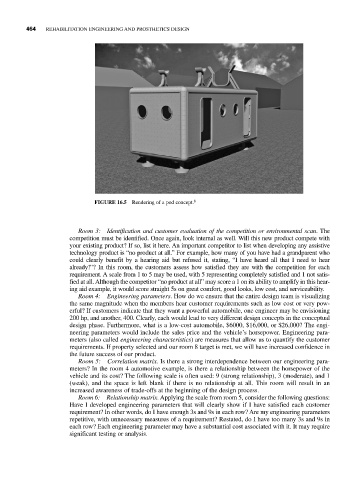Page 486 - Biomedical Engineering and Design Handbook Volume 2, Applications
P. 486
464 REHABILITATION ENGINEERING AND PROSTHETICS DESIGN
FIGURE 16.5 Rendering of a pod concept. 8
Room 3: Identification and customer evaluation of the competition or environmental scan. The
competition must be identified. Once again, look internal as well. Will this new product compete with
your existing product? If so, list it here. An important competitor to list when developing any assistive
technology product is “no product at all.” For example, how many of you have had a grandparent who
could clearly benefit by a hearing aid but refused it, stating, “I have heard all that I need to hear
already!”? In this room, the customers assess how satisfied they are with the competition for each
requirement. A scale from 1 to 5 may be used, with 5 representing completely satisfied and 1 not satis-
fied at all. Although the competitor “no product at all” may score a 1 on its ability to amplify in this hear-
ing aid example, it would score straight 5s on great comfort, good looks, low cost, and serviceability.
Room 4: Engineering parameters. How do we ensure that the entire design team is visualizing
the same magnitude when the members hear customer requirements such as low cost or very pow-
erful? If customers indicate that they want a powerful automobile, one engineer may be envisioning
200 hp, and another, 400. Clearly, each would lead to very different design concepts in the conceptual
design phase. Furthermore, what is a low-cost automobile, $6000, $16,000, or $26,000? The engi-
neering parameters would include the sales price and the vehicle’s horsepower. Engineering para-
meters (also called engineering characteristics) are measures that allow us to quantify the customer
requirements. If property selected and our room 8 target is met, we will have increased confidence in
the future success of our product.
Room 5: Correlation matrix. Is there a strong interdependence between our engineering para-
meters? In the room 4 automotive example, is there a relationship between the horsepower of the
vehicle and its cost? The following scale is often used: 9 (strong relationship), 3 (moderate), and 1
(weak), and the space is left blank if there is no relationship at all. This room will result in an
increased awareness of trade-offs at the beginning of the design process.
Room 6: Relationship matrix. Applying the scale from room 5, consider the following questions:
Have I developed engineering parameters that will clearly show if I have satisfied each customer
requirement? In other words, do I have enough 3s and 9s in each row? Are my engineering parameters
repetitive, with unnecessary measures of a requirement? Restated, do I have too many 3s and 9s in
each row? Each engineering parameter may have a substantial cost associated with it. It may require
significant testing or analysis.

